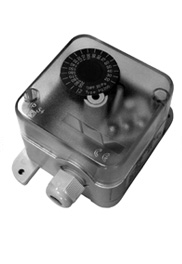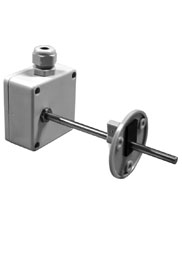Basic Antifreeze Protection Principles of Remak Air-handling Units
Basic Antifreeze Protection Principles of Remak Air-handling Units
The antifreeze protection integrated into Remak air-handling devices can be divided into three basic groups:
- Water exchangers (heaters)
- Direct evaporators (cooling)
- Plate and rotary heat exchangers
 |
 |
 |
 |
| CAP | P33 N | NS 120 | NS 130 |
Water exchangers designed for heating the inlet for the air-conditioned room, are equipped with double antifreeze protection for operation at low temperatures (i.e. if the heating medium in the heating system is not hot enough). The first antifreeze protection stage includes return water temperature sensing, while the second antifreeze protection stage is ensured by the inlet air temperature behind the heat exchanger.
The return water temperature is sensed by the high-speed responding NS 130 / Ni1000 temperature sensor to enable the control system to react fast enough when the temperature falls below permissible level. The sensor is situated directly in the water heat exchanger header on the return water side.
Inlet air temperature sensing behind the heater is performed by the NS120/Ni1000 sensor. This sensor serves for both inlet air temperature control as well as antifreeze protection. This means that if the inlet air temperature behind the heater read by this sensor is evaluated as too low, the control system will consider this fact as an antifreeze protection failure on the air side.
In rare cases and if required by the customer, it is possible to complete water heater antifreeze protection with auxiliary protection consisting of installation of the CAP 3M capillary thermostat. The capillary tube of this thermostat is installed through the whole cross-section of the heating coil battery through which the air comes. If the temperature falls below permissible level, this thermostat will activate the antifreeze protection of the connected control system.
Antifreeze protection of the water heating coil battery can only be deactivated if the correct operating temperature of both the heating medium and inlet air at the sensor in the air-handling unit is ensured.
If antifreeze protection is activated, the superset control system must immediately shut down the fans, close the inlet damper and open the control valve in the heating water circuit, thus ensuring exchanger through-heating.
Direct evaporators (cooling) installed in air-handling systems can suffer from ice accretion during transition periods (spring and autumn), or if the cooling capacity correlation (combination of the evaporator and cooling unit) has not been maintained. This ice accretion will develop in the heat-exchanging part of the direct evaporators. Finally, the ice accretion can increase pressure loss, respectively completely restrict the passage through the evaporator. To eliminate this effect and ensure antifreeze protection of the direct evaporators, CAP 3M capillary thermostats are installed on the tube plate of the evaporator's inlet side. The capillary tube is installed during the cooling circuit assembly. After connecting the refrigerant input and output, the full active length of the capillary tube is coiled on the above-mentioned tube plate. After installation, it is necessary to apply a sufficient insulation layer to eliminate possible air humidity condensation as well as to ensure transfer of the correct temperature within the evaporator to the active part of the capillary tube.
If this antifreeze protection is activated, the control signal for the cooling unit will be interrupted and the delivery of cooling capacity into the direct evaporator will simultaneously be disconnected. Then, the evaporator will be defrosted by warm inlet air. Once the tube plate temperature on the evaporator's inlet side has increased, the capillary thermostat will close the control signal circuit, and the cooling unit will be activated.
Plate and rotary heat exchangers are at risk of ice accretion if humidity of the air exhausted form the air-conditioned room is high, and the inlet (ambient) air entering the heat exchanger is at/or below freezing point. In these conditions, ice can build up on the plate heat exchanger's heat exchanging surfaces or on the rotary heat exchanger's bellows. In both cases, antifreeze protection can be ensured by sensing the outlet air behind the heat exchanger, or by sensing the pressure losses in the heat exchanger. The air temperature is read in accordance with the superset control system option. At present, VCB and WebClima control systems can be used in REMAK applications. Antifreeze protection with the VCB control units can be ensured either by the CAP 3M capillary thermostat or P33N differential pressure sensor. Instead of the temperature change behind the heat exchanger, the differential pressure sensor is activated by higher pressure loss in the plate heat exchanger, which has increased due to ice accretion on the heat exchanging surfaces. In both instances, the plate heat exchanger by-pass actuator, respectively the rotary heat exchanger antifreeze protection will be activated.
The heat exchanger antifreeze protection in the WebClima system is ensured by sensing the actual temperature behind the heat exchanger using the NS 120/Ni1000 temperature sensor. If the temperature at this sensor falls below the preset temperature, plate heat exchanger by-pass controlled (proportional) opening will be performed, respectively the rotary heat exchanger rotor speed will be controlled.
After the CAP 3M or P33 N sensors have been deactivated or the temperature at the NS 120 sensor has increased, full heat recovery will be resumed.
